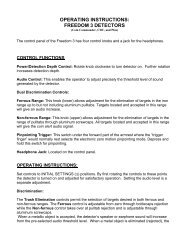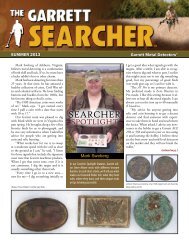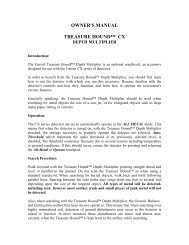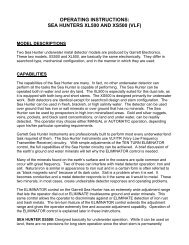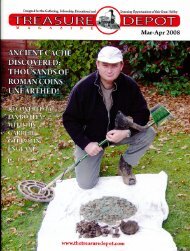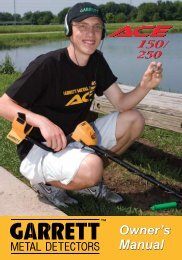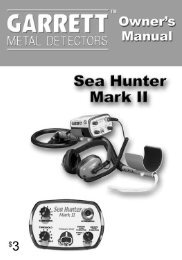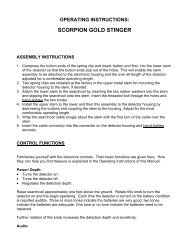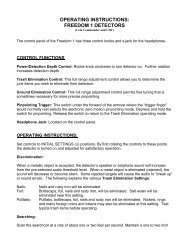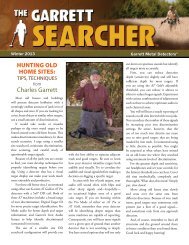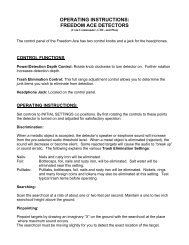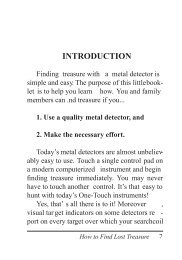Responsible Relic Recovery Of Cherokee War Artifacts - Garrett
Responsible Relic Recovery Of Cherokee War Artifacts - Garrett
Responsible Relic Recovery Of Cherokee War Artifacts - Garrett
Create successful ePaper yourself
Turn your PDF publications into a flip-book with our unique Google optimized e-Paper software.
(Left) This three-piece buck<br />
and ball load was recovered<br />
by Dave Totzke. The smaller<br />
buckshot balls measure .32<br />
inches in diameter.<br />
(Below) The author recovers<br />
a flattened .69 caliber rifle or<br />
musket ball.<br />
recovery of a nice, albeit smaller, musket ball might have<br />
satisfied a novice searcher that he or she had found the metal<br />
detector’s announced target. Before the day was out, Dave<br />
would find another similar buck and ball load with the aid<br />
of his Pro-Pointer.<br />
I have read Charles <strong>Garrett</strong>’s words and have heard him<br />
utter the phrase many times: “You can find treasure even<br />
in your own backyard!” In this case, we had found historic<br />
relics right in the Jetts’ own front yard!<br />
These musket balls and buck and ball loads were likely<br />
dropped by Texans who were firing at Indians in the creek<br />
bed below them. Some of the discovered shots had perhaps<br />
been fired back up at the Texans by the <strong>Cherokee</strong>s. Our<br />
team continued working the field during the next hour and<br />
most recovered at least a couple of musket balls. In addition,<br />
Dave, Paul, Joe Wilson, Robert Jordan, Rusty Curry and<br />
Mike Skinner each managed to recover pieces of an old iron<br />
cooking pot that appear to have been shattered many years<br />
ago by someone plowing the land.<br />
Following a quick lunch break, I struck out across the<br />
top of the hill in front of the Jett home toward the area where<br />
Robert had found the lone rifle ball weeks before. I topped<br />
the little prairie’s highest elevation and had just started<br />
down the back slope when my GTI 2500 sang out with a<br />
solid hit. It was right on the 7 mark on the scale, just where<br />
the other balls had been registering.<br />
Using my spade, I popped a six-inch-deep plug and<br />
began probing the recovery hole with my Pro-Pointer. In<br />
short order, it began vibrating and audibly rattling with the<br />
sweet sound of a solid target. From the soft soil, I retrieved<br />
a somewhat flattened hard piece of lead that was solid and<br />
heavy. Brushing it off, I quickly realized it to be a musket ball<br />
that had mushroomed on impact. It was a sobering thought<br />
These battlefield relics were dug on the main July 16 battle site. (Left to right) A<br />
1.1 oz. .69 caliber musket ball that has flattened upon impact; an intact .69 caliber<br />
musket ball which was likely never fired (notice the tip of the sprue that was not<br />
properly clipped off); a .42 caliber ball which also dropped (which appears to have<br />
not been trimmed after molding); and a properly formed .69 caliber musket ball.<br />
indeed to realize that this little pancaked treasure had likely<br />
ended someone’s life in 1839.<br />
Paul Wilson and Robert Jeffrey each soon discovered<br />
similarly flattened rifle balls while Stan found another intact<br />
ball that had obviously missed its mark. This area would<br />
prove to be the initial skirmish line where Texan scouts had<br />
been taken under fire by the <strong>Cherokee</strong>s in July 1839. A few of<br />
our recoveries were buck and ball loads in which the larger<br />
ball still possessed its little “nub” or the tab that might have<br />
been snipped off prior to packing a load.<br />
Gregg Dimmick, ballistics expert Doug Scott and Byron<br />
Johnson, Executive Director of the Texas Ranger Hall of<br />
Fame and Museum in Waco, all helped confirm that the<br />
.69-caliber and other smaller balls we had found were<br />
certainly available in 1839. With the help of Donaly Brice of<br />
the Texas State Archives, I later tracked down a July 1839<br />
document confirming that the Texas Rangers had indeed<br />
been supplied with 50 pounds of buckshot prior to the battle<br />
to use in buck and ball loads. Chief Bowles, in fact, is known<br />
to have been shot in the back by a buck and ball shot.<br />
The Jett family was kind enough to let us make an<br />
additional search of their land on April 1, and we were again<br />
able to further define the battle areas. My team this day<br />
included detectorists Mike Skinner, Robert Jordan, Richey<br />
Davidson, Brenda Davidson, Ray Wathar and Ronnie Morris,<br />
plus Vaughan <strong>Garrett</strong> and Brian McKenzie to document the<br />
recoveries with video and photos.<br />
Our search efforts were concentrated in the lower fields<br />
this day below the upper hill where many of the relics had<br />
been previously unearthed. A number of additional rifle<br />
balls were discovered within 30 yards of the twisting creek<br />
where the <strong>Cherokee</strong>s had been positioned during the Neches<br />
battle. Most of the lead balls this day were of the .69 caliber<br />
size and a few stray shots were even found on the far side of<br />
the creek, away from the main battle area.<br />
From the two concentrated areas of relic recoveries<br />
previously encountered and this hot spot near the creek,<br />
we could pretty clearly visualize the 1839 Neches battle.<br />
The terrain, the slope and the creek bed below the hill fit the<br />
various descriptions of the battlefield that were penned in<br />
1839 by some of the Texans. Beyond the creek bed, a heavy



